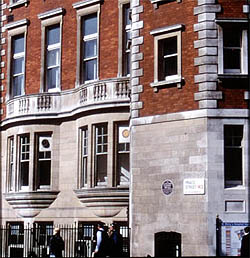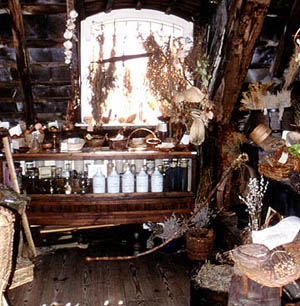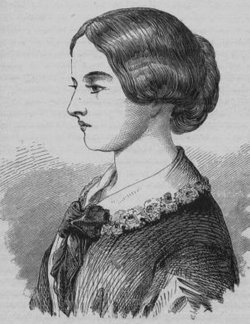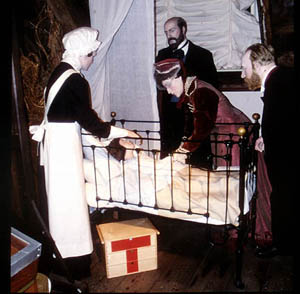A Medical Mystery Tour
by Nancy Wigston
London is full of curiosities. On a recent visit, I discovered that, in a past life, our hotel in Little Venice had been a hospital. Built in 1865 as two large homes, from 1886-1935, the hotel operated as Warrington Lodge, an "egalitarian nursing home" for "ladies of all means." Today the hotel elevator remains the oldest working lift in London, with an Art Deco facade, and an unusual width, designed to allow stretchers and trolleys up to the operating theatre. A brass plaque at the front door notes that Enigma code-breaker Alan Turing was born here in 1912. A hotel has occupied the premises since 1936; among its first distinguished guests was Sigmund Freud, who stayed here after escaping Nazi-held Vienna. Inspired by these nuggets of medical history on my very doorstep, I embarked on my own medical mystery tour. The following are a few highlights.
The Colonnade Hotel, formerly Warrington Lodge, 2 Warrington Crescent. Little Venice, London W9 1ER Tube: Warwick Ave.
Sir Alexander Fleming's Laboratory Museum
 My first discovery was an easy walk from Little Venice. In a second-floor lab in the great sprawl of St. Mary's Hospital on Praed St., visitors from all over the world arrive to pay their respects to genius. Seventy-seven years ago, in this very room, Alexander Fleming changed the course of modern medicine. "That's funny," he said, noticing the effect of a mould growing on jelly in petri dishes. Today it seems as if the good doctor has just stepped out: before me are Fleming's worktable, petri dishes, books, the silver 25th anniversary bowl presented to him by Prince Philip. My first discovery was an easy walk from Little Venice. In a second-floor lab in the great sprawl of St. Mary's Hospital on Praed St., visitors from all over the world arrive to pay their respects to genius. Seventy-seven years ago, in this very room, Alexander Fleming changed the course of modern medicine. "That's funny," he said, noticing the effect of a mould growing on jelly in petri dishes. Today it seems as if the good doctor has just stepped out: before me are Fleming's worktable, petri dishes, books, the silver 25th anniversary bowl presented to him by Prince Philip.
"A brilliant man," says the lady volunteer, before adding, "but, like most scientists, very untidy." Not only Fleming's untidiness but also the English weather were factors in his discovery of penicillium notatum. The summer of 1928 had been miserable; unseasonably cool temperatures persisted throughout Fleming's six-week vacation. Therefore he left behind his sepsis-infected petri dishes in perfect conditions for the spores that likely drifted from the lab below his, that of mould specialist C.J. LaTouch. Returning on September 3, Fleming immediately observed the destructive effect of the mould on the sepsis.
Working with Oxford pathologists Ernst Chain and Howard Flore -- who would share the Nobel Prize with him in 1945 -- Fleming revolutionized medicine with penicillin, just in time to help the wounded in World War II. This small museum, popular with students and visiting scientists alike, also reveals Dr. Fleming's playful side. A lifelong club member and billiards player, he also liked to paint "germ" paintings, using pigmented bacteria cultures in his designs.
Sir Alexander Fleming Laboratory Museum, St. Mary's Hospital, Praed St., London W2 1NY. Open Mon-Thurs, 10am-1pm. Friday, 10-5. Admission: £2. Tube: Paddington
Old Operating Theatre, Museum and Herb Garret
 South of the Thames, in the heart of Old London, visitors will find a host of medical curiosities. Not-to-be-missed is the Old Operating Theatre, which amply rewards a breathtaking climb up a winding staircase to a 300-year-old former church garret. Herbs hanging from oak beams scent the air; accompanying texts list their medicinal uses. Pomegranate, eyebright, gum Arabic, balm of Gilead, sweet almond, lily -- the names and aromas combine to evoke the poetry of distant times. Cases of instruments, on the other hand, speak more bluntly: sputum cups, an intimidating variety of forceps, a decapitating hook, some wooden nipple shields, and a trepanning set -- to mention a few noteworthy examples. South of the Thames, in the heart of Old London, visitors will find a host of medical curiosities. Not-to-be-missed is the Old Operating Theatre, which amply rewards a breathtaking climb up a winding staircase to a 300-year-old former church garret. Herbs hanging from oak beams scent the air; accompanying texts list their medicinal uses. Pomegranate, eyebright, gum Arabic, balm of Gilead, sweet almond, lily -- the names and aromas combine to evoke the poetry of distant times. Cases of instruments, on the other hand, speak more bluntly: sputum cups, an intimidating variety of forceps, a decapitating hook, some wooden nipple shields, and a trepanning set -- to mention a few noteworthy examples.
For full shock value, the restored 1823 operating theatre wins hands down. Here indigent female patients from St. Thomas's Hospital underwent surgery before public audiences. Blood-spattered aprons on wall hooks suggest the messy business performed here, so too the box of sawdust placed beneath the table to catch blood overflow (a second under the floor caught the overflow from the first). We're told that surgeons -- the best possessed a swift technique -- washed their hands "sometimes even before operating." Opiates and alcohol partially anaesthetized patients, who were then restrained by as many as half a dozen strong men.
9a St. Thomas St. open 10.30-17.00 every day, closed Dec.15-Jan.5. Admission: £4.25; for special events and lectures: http://www.thegarret.org.uk Tube: London Bridge
The Florence Nightingale Museum
 A pleasant walk from this riveting scene, The Florence Nightingale Museum honours not only the world's premier nurse, but also her less famous colleagues and supporters. Mary Seacole, for example, was a "doctress" from Jamaica who worked alongside Nightingale in The Crimean War. The museum and its excellent video portray the bloody drama of war against the prim backdrop of Victorian social norms. Wealthy young Florence balked at the duties expected of a young woman of her class; in letters, keepsakes, and photographs she comes to life, writing that her "active natureÉrequires satisfaction," while noting acerbically that "there is nothing like the tyranny of a good English family." Studying nursing in secret, she eventually won over her family; by 1854 she was superintendent of a charitable trust for "sick gentlewomen" -- meaning governesses -- at No. 1 Harley St, in the neighbourhood that Londoners fondly call "Pill Island." A pleasant walk from this riveting scene, The Florence Nightingale Museum honours not only the world's premier nurse, but also her less famous colleagues and supporters. Mary Seacole, for example, was a "doctress" from Jamaica who worked alongside Nightingale in The Crimean War. The museum and its excellent video portray the bloody drama of war against the prim backdrop of Victorian social norms. Wealthy young Florence balked at the duties expected of a young woman of her class; in letters, keepsakes, and photographs she comes to life, writing that her "active natureÉrequires satisfaction," while noting acerbically that "there is nothing like the tyranny of a good English family." Studying nursing in secret, she eventually won over her family; by 1854 she was superintendent of a charitable trust for "sick gentlewomen" -- meaning governesses -- at No. 1 Harley St, in the neighbourhood that Londoners fondly call "Pill Island."
Her two years battling appalling conditions and stubborn British administrators in The Crimea made Nightingale a heroine in her time. Sadly, her health never recovered. Living thereafter in seclusion in London, she fought on for her causes: nursing reform, soldiers' care, well-organized hospitals, plus a wide range of health issues. Championed by her supporters in Parliament and in the press, she became a national icon whose star has never dimmed. A glance at the visitor's book shows signatures from Philadelphia, Zagreb, Tokyo, Melbourne, and Toronto.
St. Thomas' Hospital, 9 Lambeth Palace Rd. Open Mon-Fri 10am-17pm; weekend and bank holidays 10am-16.30pm, admission: £1.50. Tube: Waterloo
St. Bartholomew's Hospital Place Museum
The village-like streets of Clerkenwell, in the shadow of the great dome of St. Paul's Cathedral, harbour two medical history gems. The first is the Museum at St. Bartholomew's Hospital, an institution founded by Rahere, a courtier who'd fallen sick during his 1118 pilgrimage to Rome. Cared for by monks in a "small hospital for the sick and poor," he promised, should he recover, to build a hospital in London for the sick poor. Then St Bartholomew appeared to him, instructing him to build a church in his name in Smithfield, so Rahere did that too. The new hospital was a "place of miracles" that welcomed unwed mothers, foundlings, and orphans-often from nearby Newgate Prison. The "hospitality" offered was rest, good diet, and spiritual comfort, rather than actual medical treatment. Even when Henry VIII cracked down on Catholic institutions, St. Bart's refused to close its doors.
Early treasures in the small museum include wax-sealed parchment documents from the 12th and 13th centuries and a comprehensive account of medieval medicine. A multitude of objects on display belonged to well-known St. Bart's physicians, among them Dr. William Harvey, who worked here from 1609-1643. This treasure trove of medical instruments includes ivory and bone syringes, lancets for bloodletting, cupping instruments, a child's "peg-leg" and apothecary's mortars and pestles. A 1739 malt shovel was used in the hospital brew-house, for "small [weak] beer" was considered a health necessity for patients. A rare artistic treasure is the William Hogarth staircase mural from the 1720s; the artist's colourful Biblical scenes portray the faces of actual hospital patients.
St. Bartholomew's Hospital, West Smithfield. Open Tues-Fri 10 am-16.00. Free admission. Tube: Farringdon, St. Paul's, Barbican
The Headquarters of the Most Venerable Order of St. John
 On the opposite side of Smithfield Market from St. Bart's is the headquarters of the Venerable Order of St. John, distinguished by its 1504 gate. Founded in the 11th century, the Order offered hospitality to pilgrims in Jerusalem, before relocating to the islands of Rhodes and Malta. Abolished by Henry VIII, its London headquarters later housed "The Old Jerusalem Tavern," plus a well-known publishing house. The Master of the Revels lived in The Gate, where he issued licenses for thirteen of Shakespeare's plays. On the opposite side of Smithfield Market from St. Bart's is the headquarters of the Venerable Order of St. John, distinguished by its 1504 gate. Founded in the 11th century, the Order offered hospitality to pilgrims in Jerusalem, before relocating to the islands of Rhodes and Malta. Abolished by Henry VIII, its London headquarters later housed "The Old Jerusalem Tavern," plus a well-known publishing house. The Master of the Revels lived in The Gate, where he issued licenses for thirteen of Shakespeare's plays.
Re-established in Victorian times, the Order founded a pioneering (still functioning) Ophthalmic Hospital in Jerusalem. Then, in 1887 the St. John Ambulance Association was born, to care for and transport accident victims to hospitals. No longer would men shout (as a famous quote has it) "I have broken my leg, I am a dead man!" for St. John's was there, with crews trained in First Aid. Interactive displays and memorabilia from the the Boer War to the London Blitz enliven the on-site museum, tracing the Order's growth to its now-ubiquitous presence at football matches and pop concerts. Half a million people all over the world receive First Aid training each year from the Order of St. John. One bit of St. John's history is especially intriguing for film buffs. In Malta, the Order was required to pay only a "peppercorn [token] rent" to its landlords. The fee? One Maltese falcon.
St. John's Gate, Clerkenwell. Open Mon-Fri 10am-17pm, Sat 10am-16pm. Free admission. Tube: Farringdon
More Information:
We regret that we no longer have the resources to maintain up-to-date links and/or hours and pricing details for the various sites and attractions listed on this website. For more information about the location(s) listed above, please use your favorite search engine or visit Wikipedia.
Born in Montreal, Nancy Wigston is a longtime freelance writer and critic; she has lived in Britain and Malaysia, and now lives in Georgetown, near Toronto. She is a frequent contributor to -- among other publications -- the Toronto Star and The National Post, and is a Contributing Editor to Books in Canada, a literary magazine. A former English teacher, she has taught creative and critical writing to students, and developed a course for adults on The Art of Literary Travel Writing. Her articles have won awards in Canada, where she is a member of the Canadian Chapter of the Society of American Travel Writers and the Travel Media Association of Canada.
Article and photos © 2006 Nancy Wigston
|
